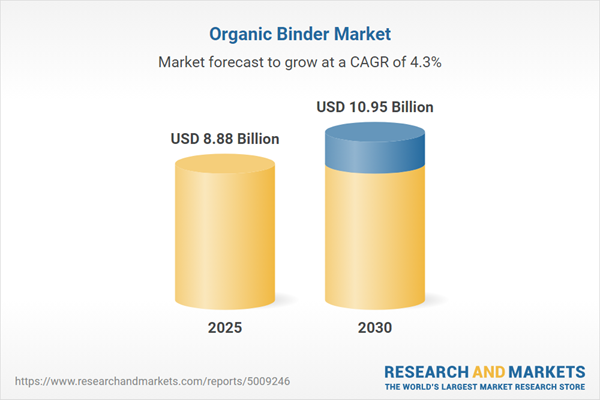Organic binders are biodegradable and, hence, are considered environmentally safe. The growing trend for the adoption of green materials is driving the demand for organic binders in several end-user industry verticals. Organic binders, based on binder type, are segregated into resins, gums, waxes, and others utilized in various end-use industries worldwide. Hence, the immense potential application of organic binder, especially for adhesion and cohesion, is further augmenting the demand in the forecast period. Furthermore, the growing food and agriculture industry is propelling market expansion along with the rising global demand for food, and thus, prolonging their shelf-life is important. The growing leather industry is further driving the global organic binder market growth over the next five years.
Organic binder market drivers:
Growing Demand for Sustainable Construction
With technological advancements, organic binders have significant market potential by introducing green building materials, promoting sustainable construction, and contributing to a lower carbon footprint. The growing construction industry worldwide, urbanization, and economic growth are further fueling the market demand in the forecast period.With rapid urbanization shaping the global economy, significant efforts are being made to provide effective infrastructural services for construction to be carried out sustainably. The growing development of smart cities and green building solutions are offering better growth prospects for the market to thrive in the forecast period.
The organic binder market is segmented into five regions worldwide:
Geography-wise, the market of organic binders is divided into North America, South America, Europe, the Middle East and Africa, and Asia-Pacific. Due to the early adoption of technology, North America and Europe are expected to hold a significant market share. In addition, with high disposable income, the citizens in these regions can spend on high-quality products containing organic binders.The Asia-Pacific region is expected to be the fastest-growing region with the expanding construction industry, growing urbanization, and the introduction of sustainable technologies. According to the American Institute of Architects, AIA Shanghai, by 2025, China will have constructed the equivalent of ten New York-size cities. The Ministry of Housing and Urban-Rural Development, MOHURD has published a notice to implement urban renewal actions in 2020 according to China's 14th Five-Year Plan. Even though China's urbanization rate stood at 64.7% in 2022, the government is developing its urban regeneration program for greener and more efficient cities to enhance urban living conditions.
Reasons for buying this report:
- Insightful Analysis: Gain detailed market insights covering major as well as emerging geographical regions, focusing on customer segments, government policies and socio-economic factors, consumer preferences, industry verticals, other sub-segments.
- Competitive Landscape: Understand the strategic maneuvers employed by key players globally to understand possible market penetration with the correct strategy.
- Market Drivers & Future Trends: Explore the dynamic factors and pivotal market trends and how they will shape up future market developments.
- Actionable Recommendations: Utilize the insights to exercise strategic decision to uncover new business streams and revenues in a dynamic environment.
- Caters to a Wide Audience: Beneficial and cost-effective for startups, research institutions, consultants, SMEs, and large enterprises.
What do businesses use our reports for?
Industry and Market Insights, Opportunity Assessment, Product Demand Forecasting, Market Entry Strategy, Geographical Expansion, Capital Investment Decisions, Regulatory Framework & Implications, New Product Development, Competitive IntelligenceReport Coverage:
- Historical data & forecasts from 2022 to 2030
- Growth Opportunities, Challenges, Supply Chain Outlook, Regulatory Framework, Customer Behaviour, and Trend Analysis
- Competitive Positioning, Strategies, and Market Share Analysis
- Revenue Growth and Forecast Assessment of segments and regions including countries
- Company Profiling (Strategies, Products, Financial Information, and Key Developments among others)
The organic binder market is segmented and analyzed as follows:
By Binder Type
- Resins
- Wax
- Gums
- Shellac
By Application
- Paints & Coatings
- Construction
- Food & Agriculture
- Pharmaceutical
- Printing & Packaging
- Others
By Geography
- North America
- South America
- Europe
- Middle East and Africa
- Asia-Pacific
Table of Contents
Companies Mentioned
- BASF SE
- DuPont de Nemours, Inc.
- Harmony Additive Pvt. Ltd.
- Foseco
- Ceraflux India Pvt. Ltd.
- Technofink
- ENDURA IPNR
- Empower Materials Inc.
- Ashland
- Vesuvius
Table Information
| Report Attribute | Details |
|---|---|
| No. of Pages | 121 |
| Published | December 2024 |
| Forecast Period | 2025 - 2030 |
| Estimated Market Value ( USD | $ 8.88 Billion |
| Forecasted Market Value ( USD | $ 10.95 Billion |
| Compound Annual Growth Rate | 4.2% |
| Regions Covered | Global |
| No. of Companies Mentioned | 10 |









